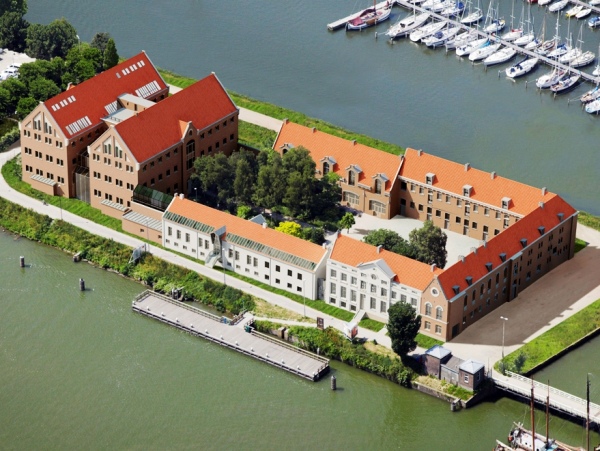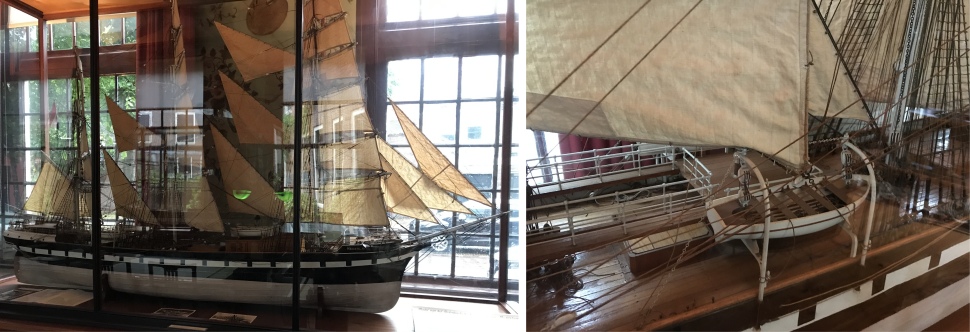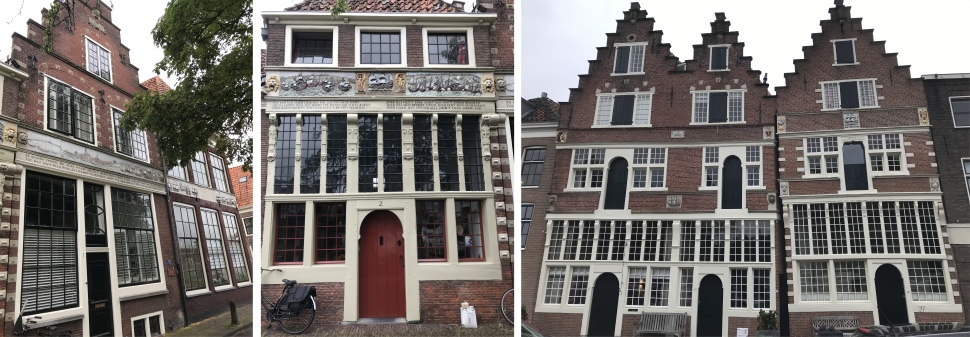With the plan settled, we headed off for a walk, calling in at the harbour master's office to book an extra night at the marina. I could not believe how difficult that would prove to be. The man quickly identified that our box was already booked out for that extra night. Not to worry, he soon identified where we should move to. But the chap just could not get his database to bend to the new requirements. After 10 minutes of cursing, he threw his hands in the air, gave up and told us just to stay where we were. What would happen to the newcomer? Not our problem.
The Museum of the 20th Century lay on the eastern side of the marina, and having never visited it, now was an ideal time. This unique museum originally opened in 1994. The museum then moved to imposing new premises on Oostereiland in the historic harbour of Hoorn. The imposing building, which is located on the island of Oostereiland between Hoorn harbour and Markermeer, served as a prison in the 19th and 20th centuries. The inmates had to carry out light work, for example, sorting raisins (krenten) which is why the prison bears the nickname De Krententuin (Raisin Garden). Following three years of renovations, the Museum of the 20th Century moved into the former prison in 2012. Over a two-year period, the former prison complex "De Krententuin" was transformed to accommodate not only the Museum of the 20th Century, but also Cinema Oostereiland, together with a Brasserie and a Tourist Information Centre.
 Museum of the 20th Century |
One large room was aptly named The Edison Room. In the Edison Room, the Museum of the 20th Century displays a wonderful overview of sound equipment from the beginning of the last century. The unique collection, made over a period of forty years, of phonographs and gramophones of collector Jelle Attema had been made available to be admired in the museum. Owner, Jelle Attema, is an expert in these old sound devices and has been restoring and selling them for years. He has contacts throughout the world enabling him to build up a wonderful collection. The room also contained a model of Edison's very first tin foil phonograph, and there were dozens of versions of Nipper, the well-known white dog who listens to the voice of his boss (His Masters Voice). In addition there were precursors of the jukebox: large wooden record players with coin inserts that were used in dance halls around 1920. A special feature is the collection in the room were dozens of tin record players made especially for children. But also talking dolls from around 1890/1920 that worked with a gramophone mechanism. Even the rare Edison Talking Doll could be seen there. The room exuded the atmosphere from the 1900s to 1930s.
There was also an exhibition in the museum: "Floris, 50 years a youth hero". Floris is a Dutch television series from 1969 and the best-watched program from that year. The exhibition contained a lot of photo and film material from the series and original props. Floris concerns a medieval knight who experiences exciting adventures. The series was extremely popular and in 1969 and 1970 many a Dutch child played a "knight" on the street. Many boys by the name of Floris were also born in the early 1970s. Both director Paul Verhoeven and actor Rutger Hauer debuted with this series.
Floris, was a knight who wanted his castle back. The story of the series goes as follows. Floris van Rosemondt has sailed the world for years. When he returns, he finds himself in the middle of the battle between the Burgundian Empire of Philip the Fair and the duchy of Charles of Gelre. His castle was captured by the latter. Together with his good friend Sindala, a fakir he met in India, he joins the Burgundians and fights with them against the soldiers of Gelre, the mercenary army of Maarten van Rossem and Lange Pier to regain their freedom and his land. Floris is young, brave and just. He is good at horse riding and sword fighting. However, he can also be rather naive, stubborn, superstitious and not too quick of understanding. To us, who did not understand all the Dutch dialogue or the background, a lot of the video footage would not have been out of place in a Monty Python sketch. Fortunately, this is compensated by the wisdom and calm nature of the fakir Sindala.
Suitably saturated with 20th century nostalgia, we walked through town. Rex was feeling exceedingly rich, but that could not alleviate his dripping nose. In his continual desire to improve his Dutch language skills, we entered a store and discovered the Dutch for handkerchief was zakdoek, and just to get some practice in he bought a pack of zakdoek. If you ever meet Rex in the street, ask him if he has a zakdoek on him.
We made our way to the train station to enquire about the steam train to Medemblik. Rain appeared in earnest just as we arrived at the station. It was a monumental cloudburst. We sought refuge for a while in the station cafe, not a delightful experience. The rain showed no sign of abating, but we did not particularly want to spend all day in the cafe, so we made our way back into town via a series of trees, shop awnings etc. Rex tried to alleviate the damage by buying himself an umbrella; a true British gentleman! I preferred the technique of walking very quickly.
I purposely steered our route back to the marina via the street of Achterom. This was deliberate since we both wanted to visit No. 17, the regent chambers of a former Roman Catholic orphanages. The impressive 18th century antiquities interior is a haven for the Dutch Cape Horners Foundation. There is a library and a collection of antique nautical instruments, including a special star globe. There are also some beautiful ship models, the original Hondius Map is part of the collection, and a wall is lined with original Hoorn wallpaper.
Cape Horn is the southernmost tip of the American continent, stretching far into the stormy sea area known as the Roaring Forties because of the thundering west winds. This cape was on the last route that was still viable for sailing ships carrying cargo, such as grain from Australia and nitrates from Chili to Europe. On these trips, rounding the Horn, was at one and the same time the blackest hour in the already difficult existence of the crew and the high point of their seamanship.
Sailors who have rounded the Horn feel united and in 1937 this led to the founding (in France) of the Amicale Internnational des Capitaines au Long Cours Cap Horniers. After the Second World War, when sail had disappeared, sections of the Amicale were set up in several countries. After a time membership was opened to every one of all ranks who had sailed on cargo ships round the Horn. The society of Dutch Cape Horn Sailors (De Vereeniging van Nederlandse Kaap-Hoornvaarders) was set up in 1959. At the invitation of the municipality, Hoorn was chosen as the registered office as it was from here that the discoverers of the Horn, Le Maire and Schouten, originated.
The Society flourished, with a membership of almost 100 still living Cape Horn sailors, and it had its own magazine in which member's experiences were published. The last reunion was held in 1979 and in 1985 the dying society became a foundation which aimed at keeping the memories of the great days of sail, particularly around Cape Horn, alive.
The Dutch Cape Horners Foundation now has almost 500 contributors or "participants", most of whom are interested in the history of seamanship in the wider sense. None have actually sailed around the Horn on cargo carrying sailing ships. The last member who actually did so, Captain Pieter G. van der Hoek, died on the 13th June 2008 at the age of 92. On the other hand, the number of members who have sailed round the Horn in charter ships and yachts during the last three decades is growing. Hoorn awards to the skippers of these ships a special trophy, whilst the Foundation awards the crews with a medallion.
As soon as we entered the foyer of the museum, dripping a puddle where we stood like drowned rats, an extremely enthusiastic, elderly gentleman got up from an adjacent room and rushed to greet us. We soon learned he was at one time a curator at the Amsterdam Maritime Museum. Now, he and a few others look after this establishment, which he took pains to point out that it was not a museum , but more a society concerned with the Cape Horners.
He excitably dragged us into one of the rooms and pointed out a large model of a German ship in a glass case. "I don't really like that model," he remarked. "Why not?" I asked inquisitively. His reply soon gave the impression he was not a fan of the Germans. "But why do you have it on display?" was my obvious question. "It belongs to a family in Dordrecht who loaned it to us," he responded, "but my pride and joy is the Nederland."
 Model of the Nederland |
 Other Exhibits at the Dutch Cape Horners Foundation |
We must have been the only visitors for a week. Still bubbling over, the man went into raptures and explained how the Baltic trade route was far more important than the Dutch East Indies trading routes, echoing similar accounts we had heard before on this trip. Wood from the Baltic States was a very important commodity for Holland in those days; a necessary requirement for ship building, buildings and foundations. The Dutch had a natural flair for building up trade associations and establishing stock exchanges, giving them the reputation of being an expert trading nation.
 Vessels in the Binnehaven |
A large book was on display in this room, "Atlas of Cape Horn". This had been written by a group of experts, and the old man had been instrumental in its creation. He excitably opened up the book and pointed out maps within it that had been created during the time when the Cape was discovered, maps that still existed in the West Indies archives at Den Haag. Rex was mesmerised by the book, and bought an English version. "A present for Meryl," he said with a wry smile on his face.
We thanked the fellow profusely for taking the time to inform us of the history. He earnestly wrote down for us details of the Maritime Museum and Navigational Centre in Amsterdam, urging us to visit it. It was perfectly obvious he was overjoyed that we had visited his pride and joy.
We briskly walked back to Duonita, and our clothing received another almighty rinse on the way. Not much sightseeing today. More and more wet clothes piled up in the boat.
 Buildings in the Slapershaven |
 "De Scheepsjongens van Bontekoe" (Bontekoe's Cabin Boys) |
 Hoofdtoren |
It is, above all, their true-to-life nature and their different characters that have ensured the threesome a place in the Dutch collective memory: Hajo is romantic and dreams of adventures in far-off lands. Padde, clumsy, fat and the butt of people's jokes, is 'Hajo's shadow' and reluctantly follows his friend to sea. And Rolf, Bontekoe's nephew and an orphan, is contemplative and calm, and often rescues the others from predicaments.
And they certainly get into plenty of predicaments. Vividly and with a great sense of pace, Fabricius describes how the crew of the Nieuw-Hoorn is hit by storms, impenetrable fog, Spaniards, becalmed seas and scurvy, the "dreaded enemy". The high point is a true event: an explosion that occurs when, through Padde's fault, a candle flame spreads via a brandy barrel to the gunpowder store. The ship is blasted into a hundred thousand pieces, amidst "hissing and cracking" it disappears into the sea.
When the cabin boys are washed ashore on Sumatra, they lose Bontekoe and begin a perilous journey through the interior of Sumatra (the mysterious atmosphere of which is captured perfectly by Fabricius, a native of Indonesia) to Bantam, Java. There, they are reunited with the survivors and with Bontekoe. They arrive back in Hoorn on New Year's Eve 1620, in the spot where they are still standing on the quayside today, thanks to Fabricius' exceptional talent for storytelling.
We walked back to the Hoofdtoren (Main Tower). This late gothic defensive structure, with its white-yellow stone on the seaward side, was visible by sailors from far out on the Hoornsche Hop, and it is still a major highlight of the historic Hoorn waterfront. The defensive tower had walls almost 1.5m thick on the seaward side, with loopholes providing a wide field of fire over the sea; it was the main link in the defence against attacks from the sea. It was constructed in 1532, but in 1614 the defensive function of tower was considered no longer necessary, and was then taken over by various civilian institutions. Today it serves as a restaurant, and we decided to dine here.
Rex struck an instant rapport with the pretty waitress. By the end of the evening she was giving him Dutch lessons - a total waste! I'm sure the waitress and her colleagues were highly amused by his attempts.
